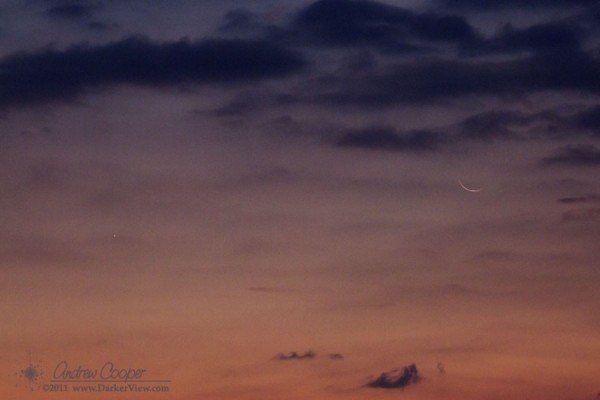Today Mercury passes through superior conjunction, passing behind the Sun as seen from the Earth. It will appear in the sunset later in the month, reaching maximum elongation on June 30th.
Tag: Mercury
Mercury Exits the Dawn
This week Mercury will be exiting the dawn sky, sliding closer to the Sun in our sky each day. It will pass through superior conjunction on May 27th, heading for an evening apparition beginning in the first days of June.
Mercury and Uranus
Mercury and Uranus will meet up in the dawn over the next few days. The pair is separated by about 3° this morning. Tomorrow morning the separation will have diminished to about 2°19′. Close approach will be on the morning of April 22nd at almost exactly 2°. On the 23rd the separation will have increased to 2°14′. Both planets will be well up, about 17° elevation at sunrise.
While Mercury is easy to pick out with the unaided eye. Uranus will require at least a pair of binoculars to see at 5.9 magnitude. The close approach will aid in finding the outer planet. Check your charts, there are a couple 6th magnitude stars just as close to Mercury to confuse for the dimmer planet.
Mercury at Maximum Elongation
Today Mercury reaches maximum elongation, the furthest point it will reach from the Sun in the sky and the highest it will be above the sunrise for this morning apparition. The planet is easily visible as a bright, starlike object about 15° above the rising Sun as the twilight begins. Over the next couple weeks Mercury will slide back into the sunrise, heading for superior conjunction on May 27.
A Thin Moon and Mercury
Tomorrow morning a thin Moon will join Mercury in the dawn. The 6.5% illuminated moon will be a bit over 6.5° from the planet. The pair will be over 15° above the horizon at sunrise. The planet Uranus is only 4.5° from Mercury, but at magnitude 5.9 it will be difficult to spot, even with a telescope, in the bright dawn.
Mercury at Inferior Conjunction
Today the planet Mercury passes through inferior conjunction, passing between the Sun and the Earth. In a week or so the planet will again be visible in the dawn sky, climbing higher each day. Maximum elongation will occur April 18th.
Mercury Exits the Evening Sky
Mercury is ending it’s first evening apparition of 2012. Over the next few days the planet will slide into the sunset heading for inferior conjunction on March 21st and a morning apparition beginning at the end of March.
Mercury at Maximum Elongation
Today Mercury reaches maximum elongation, the furthest point it will reach from the Sun in the sky and the highest it will be above the sunset this apparition. The planet is easily visible as a bright, starlike object about 15° above the setting Sun as the sky grows dark. Over the next couple weeks Mercury will slide back into the sunset, heading for inferior conjunction on Mar 21.
Postcard from the Universe – The Moon and Mercury
A very thin Moon could be seen last night. Only 1.1 days old the Moon was only 1.6% illuminated, a thin crescent indeed. A few degrees away was Mercury. I did get a couple photos with a telephoto lens before the clouds moved in and obscured the view…

The Moon and Mercury
This evening a thin crescent Moon will join Mercury in the sunset. The pair will be separated by just under 6°, at about the same elevation and 15° above the horizon at sunset. The Moon will be extremely thin, only 1.7% illuminated, while Mercury is shining at -1.2 magnitude.
